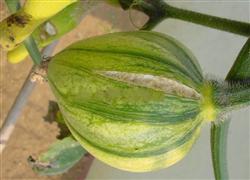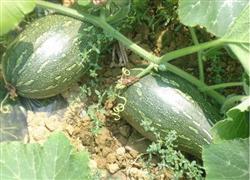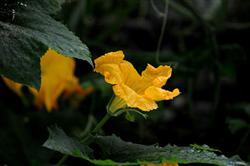Causes and control methods of cracked pumpkin

The main symptoms of pumpkin are young melons and mature melons, which will crack longitudinally, horizontally or diagonally on the surface. The crack is deep and shallow, the width is different, the serious crack can be as deep as the flesh of the melon, the seeds are exposed, and the surface of the crack is corked; the slight crack is only a small crack. If the young fruit is dehiscent, it is usually seriously cracked after the melon grows. The main cause of the disease is long-term drought or excessive water control such as prevention of gray mold, followed by sudden rainstorm or irrigation, when the pulp cells absorb water and expand, while the pericarp cells have aged and can not expand synchronously with the pulp cells, resulting in peel expansion. If the young fruit continues to grow after it expands, the crack will gradually deepen and enlarge. If the young fruit suffers some mechanical injury, it will crack at the center of the wound in the process of fruit expansion. In addition, calcium deficiency during flowering and calcium deficiency in floral organs can also lead to young fruit cracking. Control methods (1) choose the land with flat terrain, fertile soil and strong ability of water and fertilizer conservation to plant. (2) Fine soil preparation, adequate application of rotten organic fertilizer, and pay attention to the combined use of nitrogen, phosphorus and potassium fertilizer. Spray calcium fertilizer such as green Fenwei or calcium chloride during flowering. (3) rational watering to avoid soil drought or over-wetness, especially to prevent sudden flooding after long-term drought. (4) in greenhouse cultivation, the temperature should be too high and too low, and the temperature during the growing period should be kept at 18 ℃-25 ℃. (5) prevent mechanical damage to young melons during agricultural operation.
- Prev

Cultivation techniques of pumpkin in open field
The main results are as follows: 1. Chinese pumpkin must be selected for variety selection and seed treatment, and the excellent local varieties are the best, such as yellow ladle pumpkin, grinding plate pumpkin, pillow pumpkin and long-stalked pumpkin. After 1-2 days of drying, pumpkin seeds were scalded with 50 ℃ warm water for 5-10 minutes, and then soaked to accelerate germination. 2. Fertilization and soil preparation.
- Next

What if there are fewer female flowers in pumpkins?
In the process of production, I often hear melon farmers report that their pumpkins are disease-free and pest-free, with strong plants and fat leaves, but few flowers, especially female flowers, and "melon girls" are "angry to death". What is the cause of this? What can be done to save it? The answers are as follows. Pumpkin is a kind of right.
Related
- Where is it suitable to grow horseradish in China? it is expected to see the middle altitude horseradish in Alishan.
- How to prevent tomato virus disease reasonably? (Control methods included)
- Many people like to plant towel gourd on the balcony. What are the main points of this method and management?
- What crops can chili peppers be mixed with?
- Fertilization techniques and matters needing attention in Tomato
- What are the grafting techniques for peach seedlings in spring?
- Harm and control methods of root swelling disease of Chinese cabbage
- What are the pests of sweet potatoes? How to prevent and cure it?
- Symptoms, causes and Control methods of navel Rot in Tomato
- The cause of "Cucumber rotten bibcock" in Farmers' planting Cucumber and its Control Plan

